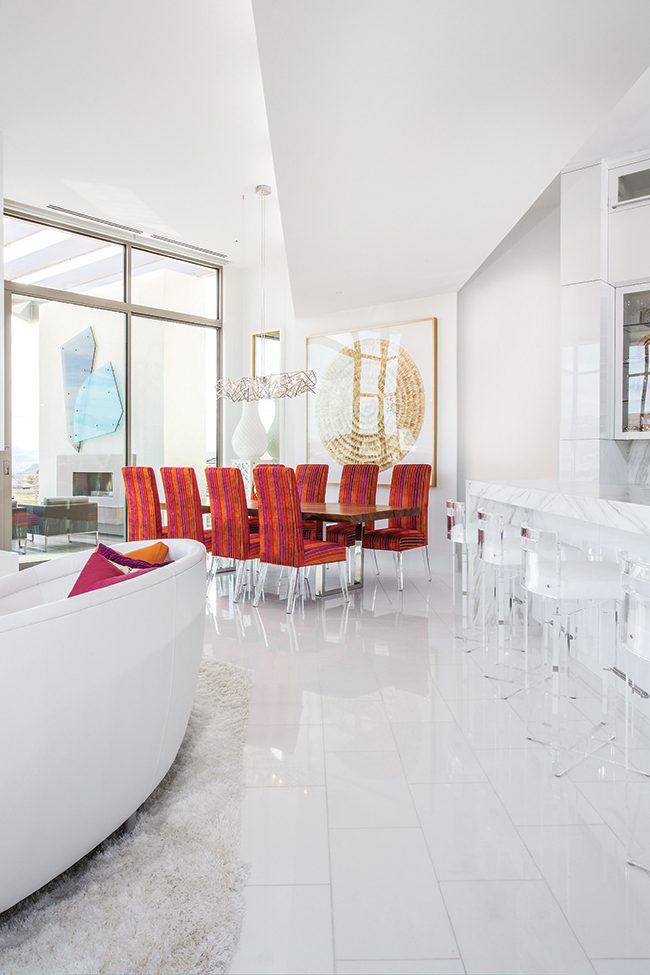Acrylic furnishings are clear winners in today’s decors.
By Don Skypeck

Everyone touts transparency and, these days, it’s hitting home. Having fallen in and out of favor over the decades, see-through furniture pieces made of acrylic—aka Lucite and Plexiglas—are enjoying yet another moment as they return to the design spotlight and high-style rooms alike. From shapely chairs to barely-there tables and boxed-in chandeliers, acrylic furnishings add modern flair and panache without detracting from an interior’s colors, patterns and textures. What’s more, they foster a light and airy interior and work brilliantly in small and freshly styled spaces alike.

“I typically incorporate Lucite into a design when I want to add something surprising to the space or when I need a piece to fulfill a specific functional requirement, but don’t want the weight, bulk or distraction that another material would provide,” says designer Jenny Samuelson, who recently paired an iconic Ghost Chair with an antique desk in a Park City project. “The combination personalizes the décor,” she explains.

Design pros also add acrylic furnishings to rid rooms of predictability and stuffiness. “Due to its transparent nature, Lucite works in virtually any setting, from modern to traditional,” Samuelson explains. “It can be dressed up or down and adds interest in a way that other materials cannot.” More and more, opaque furnishings including those made of brass, leather, wood or chrome are being accented with Lucite, adding a shot of modernity without clashing. It can also add clarity to a room’s design. “Stylistically, it’s the perfect option when one more stylized foot or tapered leg is too much,” says designer Cody Beal, citing the use of Lucite-based benches and stools, for example. “Their legs just disappear.”

Lucite has a place in most any space and works well when doubling down on an existing material would be overkill. For example, a piece of acrylic is ideal in rooms in which adding one more wood piece would simply be too much, designer Michele Dunker explains. “It offsets the weight of woodwithout competing with it. It doesn’t muddle the décor.” “Whether it is in a cabin or a city condo, a wood or metal console table might look too bulky in a room or detract from an amazing view. A Lucite alternative provides the desired function without distraction,” Samuelson adds.
Whatever piece you’re considering, Beal advises selecting high-quality. “Choose thick acrylic with heft,” he says. But don’t go overboard with the material, the pros warn. As Samuelson explains, “With any unique or trending material, less is often more. Simple touches of Lucite can be used to highlight or minimize aspects of the overall design.”

Acrylic: Past to Present
Lucite is actually a brand name for a kind of acrylic resin known by at least 18 different trade names (think Plexiglas and Perspex). Since it was formulated in the late 1920s by chemists at DuPont (Lucite) and Rohm & Haas (Plexiglas), this material has been used in everything from submarine periscopes to serving trays.
Lucite and its siblings became commercially available by 1937 and were quickly embraced by the design world. One of the earliest and most famous suites of Plexiglas furniture was commissioned in 1939 for cosmetic magnate Helena Rubinstein’s New York City apartment. Rubenstein, who was often at the forefront of cutting edge design trends, reportedly enjoyed her glamorous illuminated Plexiglas bed so much that she conducted her morning business meetings from it.
During World War II, Lucite fell from design favor, and its primary uses shifted to military applications. After the war, its many manufacturers needed commercial uses for Lucite again, and the material became a favorite for fashionable handbags and jewelry. Then, in the 1960s, it found its next resurgence with furniture designers, who found the material both flexible and chic.
Lucite fell briefly from favor again during the 1980s, despite the regrettable rage for see-through platform shoes. Then a Lucite renaissance of sorts began with Philippe Starck’s introduction of the now famous Louis Ghost Chair in 2002. Lucite’s most recent moment has continued unabated, and it continues to dazzle us today as furniture designers, decorators and style-savvy homeowners embrace its transparent beauty.

























To think, I was confesud a minute ago.